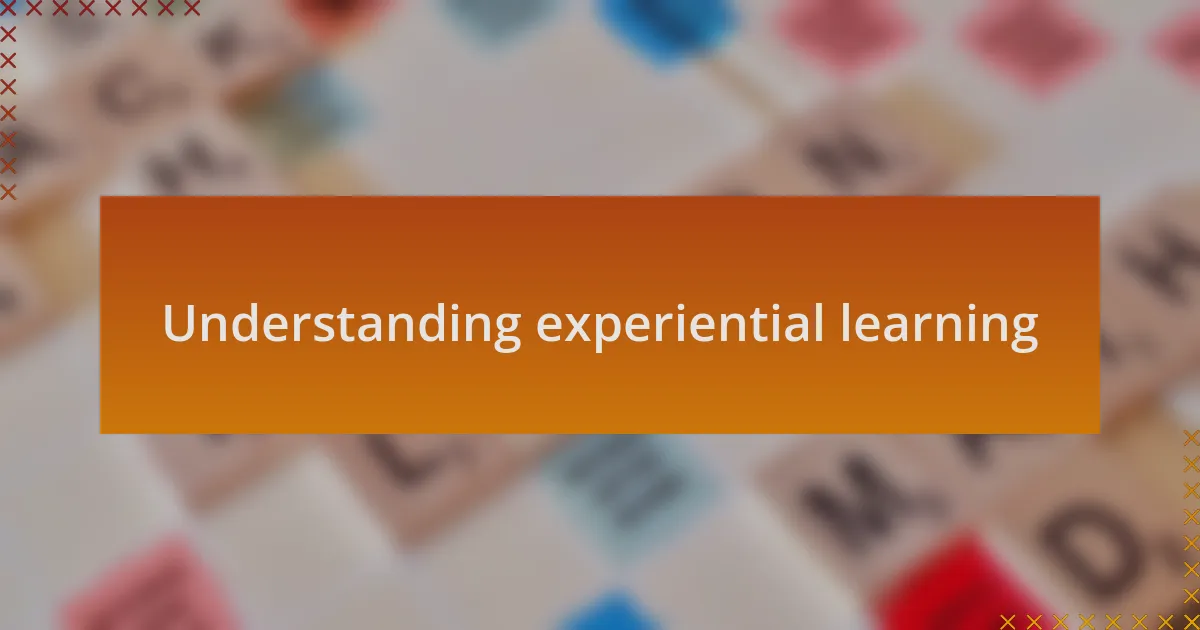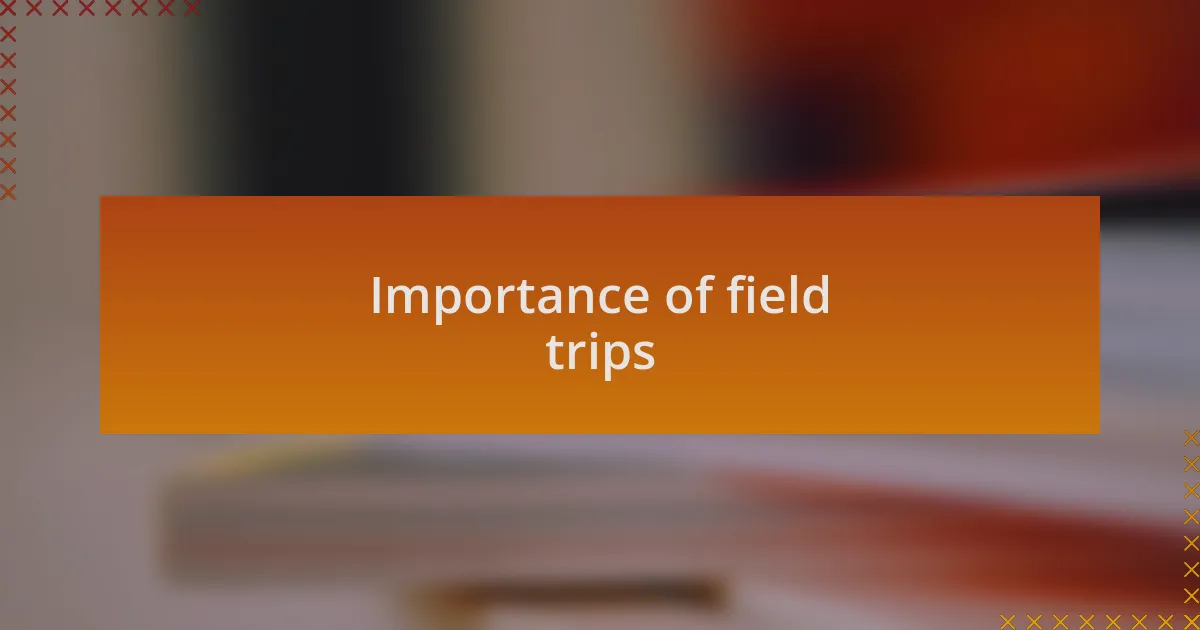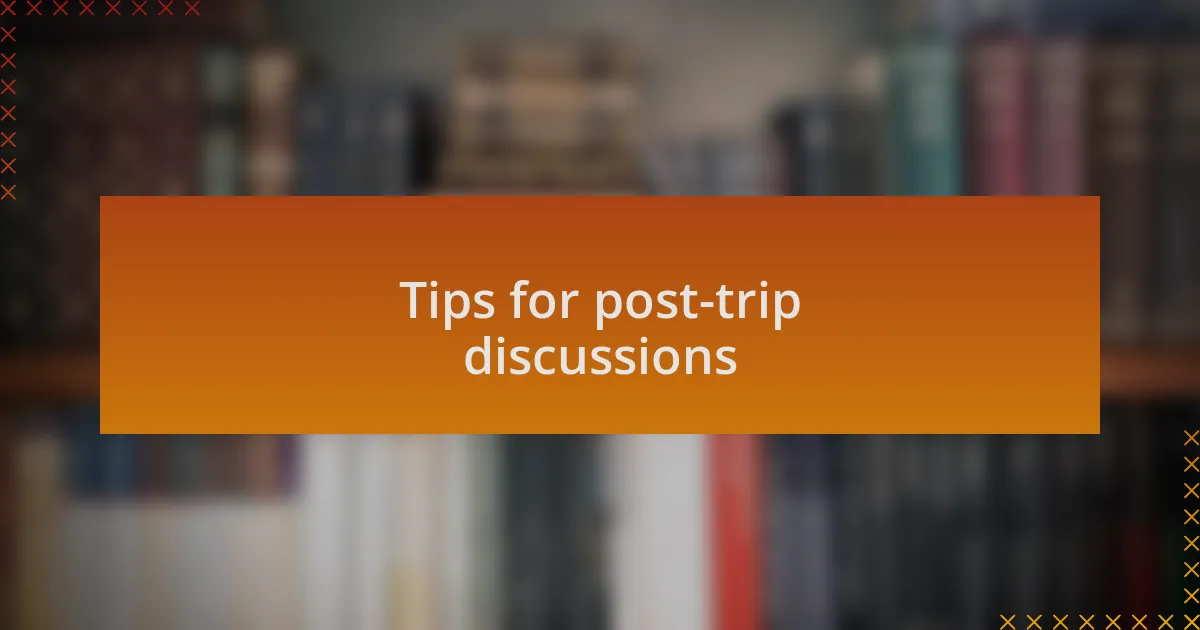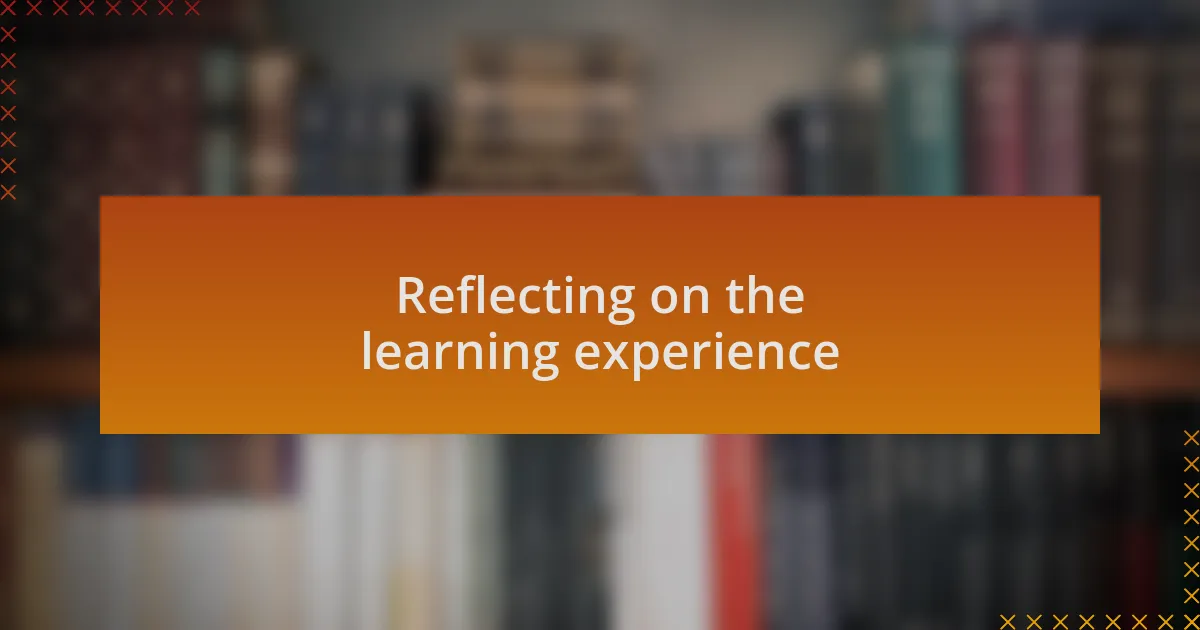Key takeaways:
- Experiential learning enhances understanding by engaging learners directly with materials, promoting critical thinking and problem-solving.
- Field trips provide hands-on experiences that connect academic concepts to real-world applications, fostering collaboration and social interaction among students.
- Successful trip preparation involves organization, involving students, and considering diverse learning styles to enhance engagement and ownership.
- Post-trip discussions and reflections solidify learning, encourage creativity, and provide opportunities for students to express their thoughts and insights.

Understanding experiential learning
Experiential learning is a dynamic process where knowledge is gained through direct experience. I still remember my first trip to a historical site; it wasn’t just about seeing artifacts but actually walking the ground where history happened. How much deeper does our understanding become when we engage with the material, rather than just reading about it?
At its core, experiential learning involves reflecting on experiences to derive meaning and insight. After a recent project where my students explored local ecosystems, we gathered to discuss what we learned. I found their perspectives so eye-opening; what they took away from the hands-on activities was far more profound than any textbook could convey.
This form of learning encourages critical thinking and problem-solving, as learners actively participate in their educational journey. Have you ever noticed how much more inclined we are to remember lessons from experiences that challenged us? It’s fascinating how real-world encounters forge deeper connections to the material, creating a lasting impact.

Importance of field trips
Field trips play an essential role in enhancing learning by providing hands-on experiences that ignite curiosity. I recall a visit to a science center where students engaged with interactive exhibits. Watching their faces light up as they conducted experiments reminded me of the sheer joy of learning through exploration. Isn’t it amazing how those tangible experiences can shift a student’s perspective on complex subjects like science and math?
Moreover, field trips foster social interaction among students, promoting teamwork and communication skills. I once witnessed a group of students collaborate during a guided nature hike, sharing ideas and helping each other navigate challenges. This spontaneous bonding moment not only strengthened their friendships but also enhanced their learning experience. Have you ever seen how cooperation can transform a trip into an unforgettable adventure?
Additionally, these excursions often tie directly into the curriculum, making learning relevant and applicable. During a history trip to a local museum, I enjoyed seeing students relate what they learned in class to the artifacts before them. The realization that history is alive and connects to their own lives sparked a deep interest that extended beyond the classroom. It’s incredible how field trips can bridge the gap between academic concepts and real-world applications.

Preparing for a successful trip
When preparing for a successful field trip, organization is key. In my experience, creating a detailed itinerary helps ensure that everyone knows what to expect, which can ease nerves and set the tone for the day. I vividly remember a trip I coordinated where we had a mix-up with transportation because I hadn’t double-checked our bus schedule. It was a lesson learned about the importance of preparation—how could I let my students down like that?
Packing essentials is another critical aspect that often gets overlooked. I always advise bringing along snacks, water, and even a small first-aid kit. On one trip, I had a student who wasn’t feeling well—having those supplies at hand made a world of difference, turning what could have been a moment of panic into a chance to calm and support. Don’t you think that being well-prepared allows students to focus more on learning and exploring?
Finally, involving students in the preparation creates excitement and ownership. I once included my class in choosing the destination and activities, and their enthusiasm was contagious! It allowed them to feel more connected to the trip, fostering a sense of responsibility that made the day more engaging. Have you ever noticed how students shine when they have a say in their learning experiences?

Key considerations for planning
One key consideration for planning a successful field trip is balancing educational goals with fun. I recall a time when I organized a visit to a science museum. Initially, I was focused solely on the curriculum, but I soon realized that if I didn’t incorporate engaging activities, the students would lose interest. Striking this balance not only enhances learning but also ensures that students walk away with memorable experiences. How can we make learning enjoyable while achieving our educational objectives?
Another important factor is assessing risk. I’ve learned to conduct thorough site visits and talk to the venue staff beforehand. On one occasion, I overlooked this step, only to discover the site had limited restroom facilities. As a result, we faced some logistical challenges that could have been easily avoided. Taking the time for a proper assessment can help you foresee potential issues and ensure safety and comfort for everyone involved.
Lastly, consider the diverse needs of your students. It’s crucial to accommodate different learning styles and abilities. I remember incorporating varying activities during a trip to a botanical garden, allowing students to choose between a guided tour and a self-exploration option. The difference in engagement was remarkable—those who preferred hands-on learning thrived, while others appreciated the structured approach. How can we ensure that every student feels included and valued during these enriching experiences?

Engaging students during the trip
Engaging students during a field trip is all about interaction. I remember one particular science field trip when I decided to turn our journey into a scavenger hunt. I crafted a list of items or phenomena for students to find and photograph throughout the museum. The excitement was palpable as they raced through the exhibits, and I watched students who typically kept to themselves come alive, eagerly sharing their finds. How can simple elements like a scavenger hunt transform a dull visit into an interactive learning adventure?
Another great way to engage students is by offering them roles during the trip. I once assigned students as “tour guides” for small groups at a historical site, giving them research tasks ahead of time. This responsibility sparked their curiosity; they took pride in sharing information with their peers and deepened their understanding in the process. Isn’t it fascinating how empowering students can foster a sense of ownership and enthusiasm for learning?
Additionally, don’t underestimate the power of reflection during the experience. Incorporating short group discussions after specific activities can create opportunities for students to share their thoughts and feelings. After a visit to an aquarium, I posed questions about their favorite sea creatures and what surprised them the most. The conversations that flowed not only helped solidify learning but also allowed students to connect with each other. What if these moments of reflection were the key to transforming insights into lasting memories?

Tips for post-trip discussions
Post-trip discussions can be a goldmine for enhancing student learning. I had one trip where, after visiting a botanical garden, we gathered in a circle to share one surprising fact each student learned. It was heartwarming to see their eyes light up as they recounted their newfound knowledge. That exchange not only deepened their understanding but also fostered a sense of community. How often do we miss these opportunities to connect on a personal level?
Another strategy is to encourage students to express their experiences through creative outlets. After a history trip to a local landmark, I invited my students to create short skits or presentations. One group creatively reenacted a historical event they learned about, and the laughter and connection brought the lessons to life. I realized then that allowing for such creativity not only keeps the enthusiasm alive but also makes learning memorable. Have you ever witnessed a lesson transform through art?
Finally, incorporating open-ended questions in your post-trip discussions can lead to deeper insights. I remember asking students what they felt was the most important takeaway from our trip to a wildlife sanctuary. The variety of answers revealed their unique perspectives and encouraged respectful dialogue. This approach can create an environment where everyone feels valued and heard. Isn’t it incredible how such simple conversations can unlock meaningful learning experiences?

Reflecting on the learning experience
Reflecting on the learning experience is crucial for solidifying the knowledge gained during a field trip. I recall after a visit to a science museum, I gave my students a few moments to jot down their thoughts in a journal. When they shared, I was struck by how many unfamiliar concepts had sparked their curiosity. Have you ever noticed how a brief reflection can ignite a lifelong passion for a subject?
Another aspect to consider is the power of individual reflection. After a trip to a cultural festival, I asked students to write a short letter to their future selves about what they learned and how it might influence their actions. Reading through their letters later, I found it both moving and insightful to see how deeply they were connecting their experiences to their personal lives. Isn’t it fascinating how our reflections can shape our future decisions?
Lastly, integrating group reflection encourages collaborative learning. During a nature hike, we gathered to discuss what elements of the environment stood out most to each of us. To my surprise, each student’s perspective added a layer of understanding to the whole experience. This enriched our collective knowledge while reinforcing the idea that everyone’s voice matters. How often do we create space for such valuable exchanges?